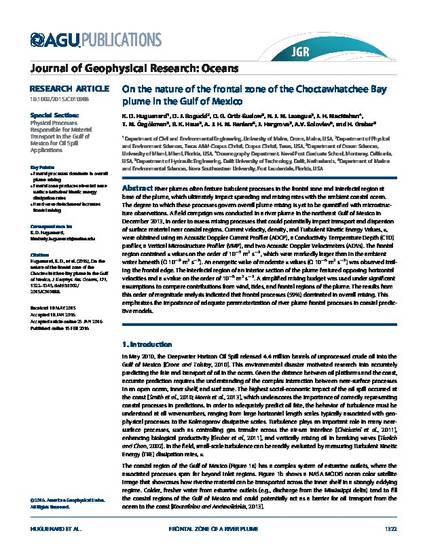
- River plume,
- Mixing,
- TKE dissipation,
- Frontal zone,
- Coastal processes,
- Estuarine processes,
- Nearshore processes,
- Turbulence,
- Diffusion,
- and Mixing processes
River plumes often feature turbulent processes in the frontal zone and interfacial region at base of the plume, which ultimately impact spreading and mixing rates with the ambient coastal ocean. The degree to which these processes govern overall plume mixing is yet to be quantified with microstructure observations. A field campaign was conducted in a river plume in the northeast Gulf of Mexico in December 2013, in order to assess mixing processes that could potentially impact transport and dispersion of surface material near coastal regions. Current velocity, density, and Turbulent Kinetic Energy Values, ε, were obtained using an Acoustic Doppler Current Profiler (ADCP), a Conductivity Temperature Depth (CTD) profiler, a Vertical Microstructure Profiler (VMP), and two Acoustic Doppler Velocimeters (ADVs). The frontal region contained ε values on the order of 10−5 m2 s−3, which were markedly larger than in the ambient water beneath (O 10−9 m2s−3). An energetic wake of moderate ε values (O 10−6 m2 s−3) was observed trailing the frontal edge. The interfacial region of an interior section of the plume featured opposing horizontal velocities and a ε value on the order of 10−6 m2 s−3. A simplified mixing budget was used under significant assumptions to compare contributions from wind, tides, and frontal regions of the plume. The results from this order of magnitude analysis indicated that frontal processes (59%) dominated in overall mixing. This emphasizes the importance of adequate parameterization of river plume frontal processes in coastal predictive models.
Available at: http://works.bepress.com/alexander-soloviev/80/

©2016. American Geophysical Union